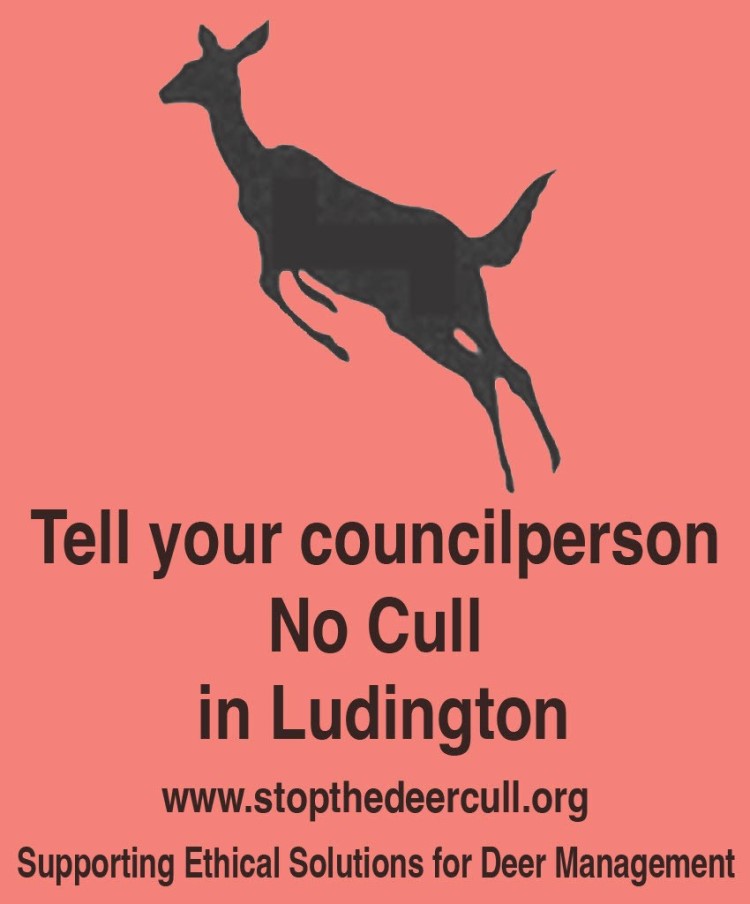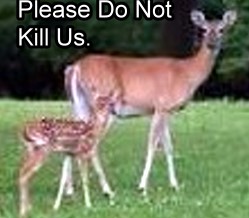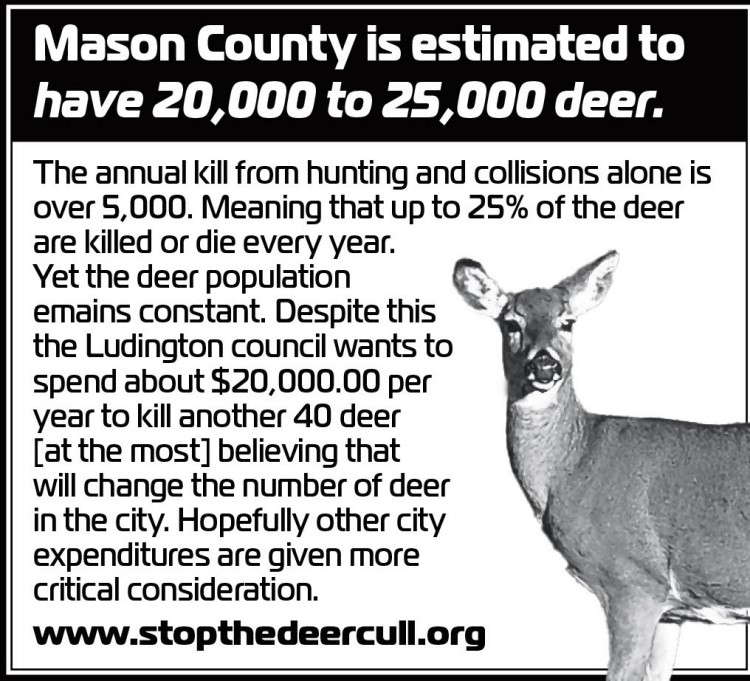
Recent ad and template
for yard signs to be placed later this year.
Short on time and just want a quick synopsis as to why
we stand against deer culls click here.
Charlevoix, Michigan undertook the foolish step of
starting
deer culls in 2024. If they had reviewed Big Rapids, Michigan
experience of dismal failure with culls having conducted them for
over fifteen years Charlevoix city officials would have known they were
starting to spend taxpayer money on a project that never ends. Simply
put deer culls are USELESS, DANGEROUS AND
EXPENSIVE. The cost of the cull was $600.00 for every deer taken. Not a
very good investment. Click on links for stories on each. Learn more about
the history of the relationship between the white-tailed deer and humans
by
reading this if you do you will not longer support culls if you do
now.
To see how many deer are in
Ludington use the Camera Study Analysis link to the left.
The Michigan DNR publishes a lot of information that contradicts their
claims that deer culls are useful in managing deer. It takes a lot of
work to find the information because this agency proliferates a lot of
publications. For example they continue to claim culls are needed to
control deer populations while publishing this "LANSING, Mich. (WJRT) -
The Michigan Department of Natural Resources is reporting
a significant drop in deer
harvest numbers for the 2023 hunting season. Hunters reported
taking slightly less than 275,000 deer last fall, which is about 9% less
than the more than 300,000 deer culled during the 2022 hunting season".
At the same time According to the Michigan Department of Natural
Resources, approximately 590,000 people obtained a deer tag in Michigan
in 2023, which is 1% more
compared to the previous year. So deer tag sales were up 1%
and the harvest was down over 9%. Does this indicate to you that there
are more deer?
The DNR has a deer management plan that contains many apparent
contradictions and falsehoods. It is long but if you want to understand
the real reason the DNR pushes culls you need to study it. Of course it
is about money "isn't everything".
Get it here
Every deer hunter I talk to reports seeing fewer deer in 2023.
Jesus mentions animals in the Bible in various contexts. For instance,
in Matthew 6:26, Jesus says, “Look at the birds of the air; they do
not sow or reap or store away in barns, and yet your heavenly Father
feeds them. Are you not much more valuable than they?” This verse
highlights God’s care for all living creatures. Animals play a
significant role in the Scriptures, representing both God’s creation and
serving as powerful symbols of spiritual truths. They demonstrate God’s
care for all living creatures and provide us with valuable lessons about
faith, obedience, and stewardship. There is only one justification
for killing an animal and that is when it is necessary for your
survival. To some extent hunting for sport in order to have the
skills necessary to survive may be justifiable. But killing an animal
because it eats your flowers is not.
Scripture teaches us that God tolerated animal sacrifices because of the
seriousness of sin. After Christ atoned for our sins animal sacrifices
were no longer welcomed by God.
Matthew 9:13 Go and learn what this means: ‘I desire mercy, and not
sacrifice.’ For I came not to call the righteous, but sinners.” Hosea
6:6 For I desire steadfast love and not sacrifice, the knowledge of God
rather than burnt offerings.
Killing deer or any animal for that matter because
they eat your flowers is evil. The people that push for culls know this
and that is why they all lie about Lyme Disease, Chronic Wasting Disease
and Overpopulation to justify their evil deed. Check out the facts on
all of these made up excuses to murder deer and you will find they are
all untrue. Add to this made-up stories about coyotes hunting deer in
your city, deer attacking dogs then coming back and breaking into a
house and common sense should tell you how far some people are
willing to go to make someone else protect their precious flowers when
for under $50.00 they could purchase a motion controlled sprinkler and
do it themselves without killing anything. Lazy, stupid, evil, cheap or
cruel pick your reason but it is one of these.

Click on photo to go to our Go Fund Me Page. 100%
goes to paying for advertisements to raise awareness about deer culls
and DNR abuses. Or donate using PayPal below.

If you like reading fiction I suggest you read Mayor Barnett's
article published in the Mason County Press on September 27, 2023.
Click Here Keep in mind that the total Mason Count deer
population is estimated to be about 20,000 deer or roughly 40 deer per
square mile in the 495 square miles of land in the county. The mayor
seems to think there are more than twice the number of deer per square
mile in the city as in the surrounding woodland.
As far as I can determine the USDA does not provide any type of
notice or safety precaution notices when they conduct a deer cull near
your home. You should contact the
Ludington
city manager's office or your council person and demand to know if
there will be any cull activity near your home or where you or your
children might be at risk. Go here for
email and telephone contact information.

Click on photo to see our ad in the Mason County and
Oceana County Press
See who voted for the cull in 2023
Click here
Watch for our new ads in the Ludington Daily News
November 10th

Government bureaucrats always think they can manage
wildlife better than nature, their record on this over time indicates
this to be wrong. For them it is always about money and that is why they
are almost always wrong.
We do not dispute that a territory can become
overpopulated with deer, likewise it can become under populated. Both
conditions have serious effects on the ecology of the territory. Nature
is the best source of maintaining balance but humans are usually too
impatient for this. One of the main problems is that humans rarely
bother to find out what the population of the deer herd is but rather
rely on antidotal evidence derived from random sightings and then always
resort to lethal means to correct a problem that may not even exist.
There are many not lethal ways to remove deer from a territory that work
much better than culls and will not destroy the natural balance.
The
MISSOURI DEPARTMENT OF CONSERVATION has published an excellent study
on this subject. It is not bias like what we get from the Michigan DNR
or the Ludington Mayor and city council it is just factual and
informative.

The following was presented to the city council on November 27th 2023.
We have presented numerous common sense comments about the futility of
deer culls at the Ludington City Council meetings held the second and
forth Mondays at 6:00 PM at the city hall building.
When it comes to reducing the number of deer in the city there is
nothing you or anyone else can do that will accomplish that because of
the way nature has responded to the threats to the White-Tailed Deer’s
survival. The following data taken from DNR published information
illustrates this fact.
The best estimate of the number of deer in Mason County puts the
population at 20,000 to 25,000. There are more deer than people in Mason
County. I guess some of you should be grateful that deer cannot vote.
1. Over 5000 deer are killed each year in Mason County by hunters and
collisions.
2. Plus, an unknown number dies from other causes every year.
3. That means about 25% of the deer population is killed off each year.
4. Notwithstanding this the deer reproduce at a rate that allows the
deer population to remain steady or even increase.
5. Despite these facts the Ludington City Council appears to believe
that killing a few more deer, a maximum of 40, will make a difference in
the urban deer population.
6. The only reduction a deer cull will make is to the city treasury.
7. Urban deer culls are useless, dangerous, and expensive.
8. Do we know who the so called “Sharpshooters” are. Do you know their
names? Have you seen proof of their qualifications? Or are you inviting
armed men to shoot high powered rifles in our town based on something
the government told you? We all know how reliable that is!
9. Please rethink this deer cull and then vote no on wasting our money
and putting us in danger.

|
Read about the biggest
lie told concerning the Ludington Deer Cull:
Click Here

When you cull a doe in January, February or
March what are you really killing.
The following information illustrates that chemical ground water
contamination can and does result in venison that is unsafe to eat.
Since no surface water, soil or vegetation in northwest Ludington
have been tested and that this area has significant ground water
contamination of trichloroethylene (TCE), hexavalent chromium, and
cyanide I urge that all venison resulting from the deer cull in
Ludington be tested for contamination until such time as the other
surface test can be completed.
“The Michigan departments of Health and Human Services (MDHHS)
and Natural Resources (DNR) Thursday issued a ‘Do Not Eat’ advisory for
deer taken within approximately five miles of Clark’s Marsh in Oscoda
Township.”
The advisory is due to high levels of PFOS (perfluoro octane
sulfonic acid) found in a single deer taken about two miles from Clark’s
Marsh, which borders the former Wurtsmith Air Force Base.
Scientists first discovered toxic PFAS contamination at the
former Wurtsmith Air Force base in Oscoda, Michigan, over two decades
ago. From the 1970s until at least the base’s closure in 1993, the Air
Force sprayed PFAS-laden AFFF at Wurtsmith during training exercises to
extinguish fires, and regularly disposed of spent AFFF in grassy areas
of the base.
It should come as no surprise that these
activities caused massive groundwater contamination —
contamination that is running largely unchecked through the Oscoda area
due to the Air Force’s failure to control and clean up the PFAS plumes
from the base.
The question to cull or not to cull is complex and there are
reasonable arguments for both sides of the debate. But one thing is
clear, irresponsible wildlife management by governments at all levels
created the problem in the first place. Now worldwide governments are
using the same bogus arguments to justify culls in a vain attempt to
placate an unhappy citizenry albeit a small but vocal minatory. In
Michigan the DNR is handing off the responsibility for managing deer
herds to local communities by promoting culls and making a profit by
doing so. And gullible local officials are buying it. Culls come at a
high price with no guaranteed results. So the cost can be $500.00,
$1000.00, $2000.00, or more for each deer harvested. If humans stayed
out of it nature would eventually restore the balance but that takes
time and one thing we do not have is patients.
This is an issue all over the world, not just in Ludington or
Michigan or the United States. Read this article about
deer culls in Scotland. It clearly demonstrates why it is futile for
a community like Ludington to waste precious resources trying to do what
an entire nation cannot.
At the local level there is no chance that any effort will have
any meaningful effect on deer population. The DNR knows that they
created a problem that they cannot solve so they are passing it
down to us and others and making money doing so.

Deer culls are a political knee jerk reaction to an issue that
requires a far more complex strategy than just killing the perceived
culprit. I could go into what I suspect is the real reason culls are
advised or suggested as good or suitable by the USDA/DNR but that is not
the reason for this report. Our concern is for the well-being of the
citizens of Ludington, Michigan. Urban deer culls do not contribute to
this, they derogate it.
Title: Analysis of the Ineffectiveness of White-Tailed Deer Culls in
Michigan.
Executive Summary:
White-Tailed deer (Odocoileus virginianus) populations in Michigan have
been subject to culling programs as a means of managing their numbers
and mitigating the associated ecological and agricultural impacts.
However, this report aims to explore and highlight the reasons behind
the apparent ineffectiveness of White-Tailed deer culls in the state.
Various factors contribute to the challenges faced by culling programs,
including ecological dynamics, social aspects, and the practical
difficulties associated with large-scale culling efforts.
1. Ecological Complexity:
• White-Tailed deer populations are influenced by various ecological
factors such as food availability, predation, and weather conditions.
The complexity of these interactions makes it challenging to predict and
control population numbers through culling alone.
• Culling programs often fail to address the root causes of
overpopulation, such as habitat loss and alteration, which can lead to
increased reproductive rates and deer-human conflicts.
2. Reproductive Rates and Migration:
• White-Tailed deer are known for their high reproductive rates, and
culling efforts may not be able to keep up with the natural increase in
population.
• Migration patterns of deer populations can also complicate culling
programs, as individuals from neighboring areas may replenish the culled
populations.
3. Social Resistance and Ethical Concerns:
• Culling programs often face significant social resistance from
communities and animal welfare advocates. Public opposition can lead to
legal challenges, limiting the effectiveness of culling initiatives.
• Ethical concerns surrounding the killing of wildlife, especially
charismatic species like White-Tailed deer, can erode public support for
culling efforts.
4. Inadequate Funding and Resources:
• Culling programs require substantial financial resources and manpower
to be effective. Inadequate funding may result in insufficient
monitoring, data collection, and enforcement, reducing the overall
impact of culling on deer populations.
5. Lack of Comprehensive Management Strategies:
• Successful deer management requires a holistic approach that includes
habitat restoration, public education, and community engagement. Culling
programs, when implemented in isolation, may fail to address these
broader aspects of population control.
6. Monitoring and Evaluation Challenges:
• The effectiveness of culling programs is often difficult to assess due
to inadequate monitoring and evaluation mechanisms. Lack of accurate
data on population dynamics and ecological impacts hinders the ability
to refine and improve culling strategies.
Recommendations:
1. Integrated Management Approach:
• Implement comprehensive deer management strategies that address not
only population control through culling but also habitat restoration,
public education, and community involvement.
2. Public Engagement and Education:
• Develop and implement public awareness campaigns to educate
communities about the ecological impacts of overpopulation and the need
for comprehensive management strategies.
3. Adaptive Management:
• Employ adaptive management practices that allow for continuous
monitoring, evaluation, and adjustment of culling programs based on
scientific evidence and community feedback.
4. Collaboration with Stakeholders:
• Foster collaboration between wildlife agencies, researchers, local
communities, and advocacy groups to build consensus and support for
effective deer management strategies.
5. Research and Innovation:
• Invest in research to better understand the ecological dynamics of
White-Tailed deer populations and explore innovative, non-lethal methods
for population control.
In conclusion, addressing the challenges associated with White-Tailed
deer overpopulation in Michigan requires a multifaceted and adaptive
approach that goes beyond culling. By considering ecological dynamics,
social factors, and ethical considerations, a more sustainable and
effective deer management strategy can be developed and implemented.

The White-Tailed Deer is immune to Lyme disease so obviously cannot
spread it. A tick may hitch a ride but if the deer is alive, you will
not get close enough to it for the tick to jump onto you. The recorded
Lyme disease numbers are very low for Mason County but just because a
case is recorded here does not mean the infection originated here and
vice versa. So it is very difficult to be accurate about how many cases
originate in Mason County.
There has never been a case of Chronic Wasting Disease in Mason County
and very few anywhere in Michigan (the last count I could find prior to
2022 was 18) most of these are farm raised deer in Southeast Michigan,
not in a wild heard. According to the CDC there has never been a case of
a human having it.
In 2022 a total of 10200 deer were tested for CWD and there were 16
positives, 13 of these positive deer came from Gratiot, Ionia, Jackson,
Kent, and Montcalm counties, most from farm raised animals. This may be
part of the 18 referred to above or additional to them I am not sure.
The only way to get an accurate count of the deer population in an area
is a fly over, using Infar red equipment. Grand Haven did this a few
years ago because of claims of hundreds of deer in the city and they
counted fewer than sixty. You cannot accurately calculate the number of
deer in an area.
Comparing crop damage to flower damage is not valid, a yard can be
protected by a $50.00 motion sensor sprinkler. Crops are a farmer’s
livelihood, yet many will not kill the deer. Hazing works much better
for farmers and would for the city but does require some work.
Of course, the current deer in Ludington were not here before us, most
only live five or six years in the wild, a few will live to ten or more
years but historical photographs show many deer taken around here over a
hundred years ago. And I have seen these photos and that is more than I
can say about other photos referred to. When I requested them, I was
told there were none.
Culls are expensive and do not result in fewer deer, once started they
last forever so your tax dollars will be paying for this year after year
while the streets and sidewalks continue to deteriorate. Most of us and
many tourist visit the state park and it is loaded with deer that the
DNR will never allow to be culled. This combined with the entire area
surrounding Ludington being heavily populated with deer makes the idea
of a Ludington cull ludicrous.
Revision of the "NATURAL RESOURCES AND ENVIRONMENTAL PROTECTION
ACT Act 451 of 1994 - (7) An individual shall not hunt with a firearm
within 150 yards of an occupied building, dwelling, house, residence, or
cabin, or any barn or other building used in connection with a farm
operation, without obtaining the written permission of the owner,
renter, or occupant of the property".
By replacing the word hunt with use a firearm and change 150
yards to 400 yards.
Or at the very least mandating that the DNR obey the existing
law.
If you live in Michigan District 2 contact Senator Jon Bumstead
senjbumstead@senate.michigan.gov and Congressman Curt VanderWall
CurtisVanderWall@house.mi.gov and tell them you want the DNR to
follow the law or change the law so they must follow it.
|